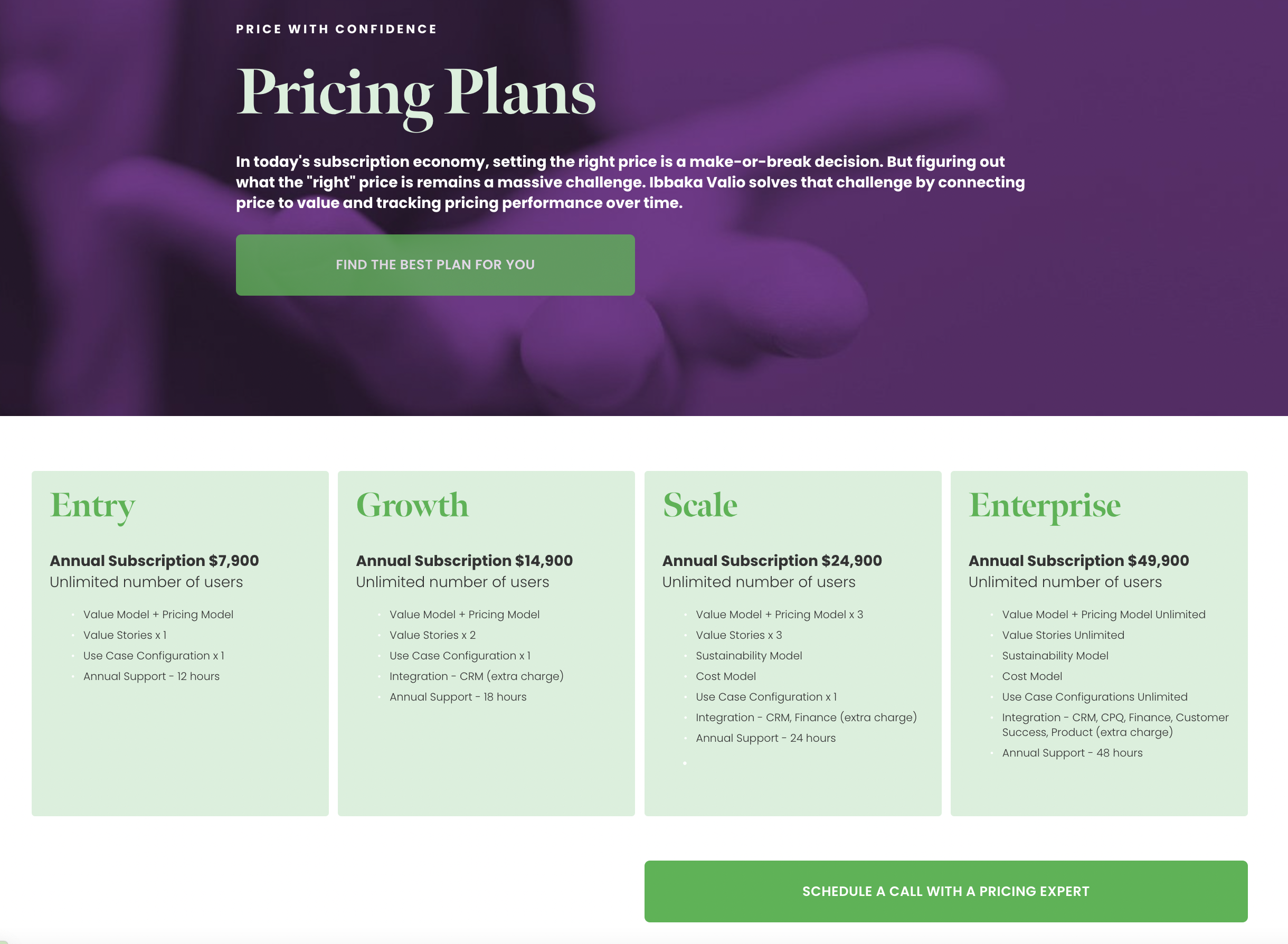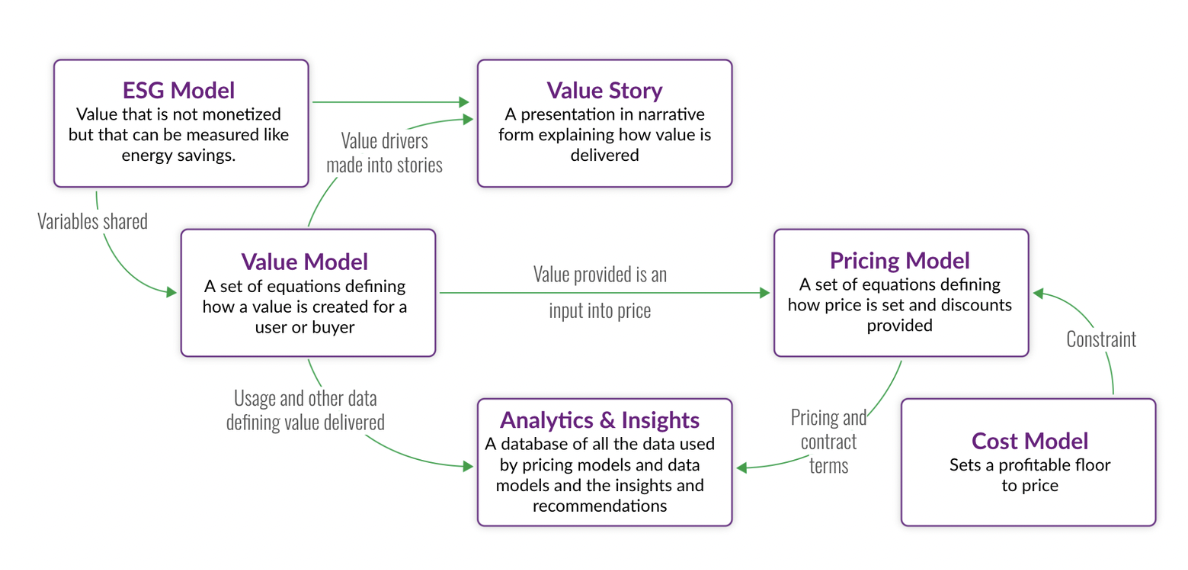How Ibbaka prices Ibbaka Valio
Steven Forth is a Managing Partner at Ibbaka. See his Skill Profile on Ibbaka Talio.
Ibbaka helps B2B SaaS companies package and price to optimize for growth. Solutions are delivered through Ibbaka Valio, a software platform to manage value and pricing models and to execute on value based pricing. Here is how Valio is priced.
We offer four tiers: Entry, Growth, Scale and Enterprise.
The key pricing metric is the number of models and value stories supported.
Additional fences, that help guide a buyer to the right platform, are additional types of models (for sustainability and costs), the number of use cases supported and integrations.
Ibbaka supports Valio with consulting services on pricing strategy and tactics, package and pricing design, and value based go-to-market execution.
Ibbaka Valio is designed for B2B SaaS companies and other companies that provide value though software and data, like Industrial Internet of Things (IIoT) companies.
To understand Valio pricing we need to explain how Valio provides value
Valio is where you manage value and pricing models, generate the value stories used to communicate value in your go-to-market process, and collect and analyse data about value and pricing.
Most companies do this in spreadsheets. This causes a cascade of problems.
The spreadsheets are modified and become inconsistent
Ease of use erodes
Integrating data across the diferent (often inconsistent) spreadsheets is difficult
Advanced analytics happens outside of the spreadsheet
Spreadsheets are a poor way to tell a value story to a potential, or current, customer
Valio addresses all of these challenges by moving models from spreadsheets into an integrate platform that brings together the models, presentation tools (value stories) and analytics.
Why four packages?
After much discussion with customers and market analysis we ended up with four packages. We also modeled three package and five package approaches, but four was a better fit. Three packages would not have allowed us to have both the entry level package and the enterprise package, and we needed both to address the range of B2B SaaS companies in our market. Five seemed too many, and we wanted to hold the fifth slot available for a future freemium offer.
Entry - US$7,900 per year - for companies with one product for one market segment
We wanted to start with an easy to adopt plan suitable for early stage companies. Ibabka is an early stage company itself, and several of us are active angel investors. Getting pricing right early in a company’s evolution and having a place to gather and analyse the relevant data is important and we wanted this to be affordable.
Growth - US$14,900 per year - for companies with one product sold in two ways
This is the package for companies that have initial product market fit and have begun to grow. These companies have one offer, possibly with a tiered GBB (Good Better Best), platform with extensions or one big package package design. Go-to-Market is focussed a this stage and the growth motion is generally Sales Led Growth or Product Led Growth.
Scale - US$24,900 - for companies with a product supporting multiple use cases and market segments
This is the most popular plan and is for companies that are scaling their revenue. Most companies selecting this package will have ARR of between US$5 million and $50 million. They are generally still focussed on one use case, have more than one market segment and tell their value stories in several ways.
Enterprise - US$49,000 - for companies with multiple products, channels and go-to-market strategies
This plan is for larger companies, generally with ARR of $50 million or more who support multiple use cases, are targeting several market segments and who may be working with channel partners. They need a solution that is as scalable and extensible as their own offerings.
Why are value models and pricing models needed?
Ibbaka’s approach is model driven. Some say pricing should be data driven, but data without a model to interpret it is meaningless. Ibbaka puts value and pricing data into the context of models and then connects them to deliver insights that are not available when value and pricing are managed independent of each other.
The model based approach makes it possible to connect value and price across the customer life cycle, make sure that prices meet internal margin requirements and to capture non economic, but quantifiable value, like energy savings or greenhouse gas emissions. The results are
Higher average contract value
Faster pipeline velocity and close rates
Recurring revenue growth
Better performance on Net Revenue Retention
Each model makes the others more valuable, and data is shared across models connecting them, so that one can make sure the critical business requirement is met.
Value grows faster than Price grows faster than Cost
Why use the number of models to price? Why not the number of users?
Many companies in the value management space price on the number of users. We do not think this is a good pricing metric as it does not track value. We want to make sure that Valio is available to anyone in the organization that needs it. A lot of different people are concerned with pricing and will want to be able to see value and pricing insights.
Product management and product marketing
Marketing and demand generation
Pre sales and sales
Implementation
Customer success
Finance
It is hard to construct a user based pricing model that tracks value for all of these people.
Valio provides value by managing, connecting and analysing value and pricing data and by making it easy to tell value stories. So we have used the number of paired value and pricing models as our main pricing metric.
Other metrics are used to fence the four different packages and guide buyers to the package they need. These are the number of these fences:
Value Stories
Use Case Configurations (how many of the customer’s different use cases and configurations are supported)
ESG models
Cost Models
Integrations
There is no limit on the number of users.
What is involved in adopting Valio?
To get the full value of Valio you need to have well thought out packaging, a value model and a pricing model. You will also need to be able to tell compelling stories about how your solution delivers value.
Analysis of the performance of your current pricing, packaging and discounting are also an important part of the puzzle as they give insights into how pricing should be designed.
Ibbaka delivers everything you need to make sure that your packaging and pricing are optimized for growth.
Pricing strategy and alignment
Analysis of current performance
Market research on value perception and willingness to pay (WTP)
Package and bundle defintion
Pricing model design
Value story creation
Value based sales training
Ongoing coaching and support
Predictive models for churn, ARR and revenue



